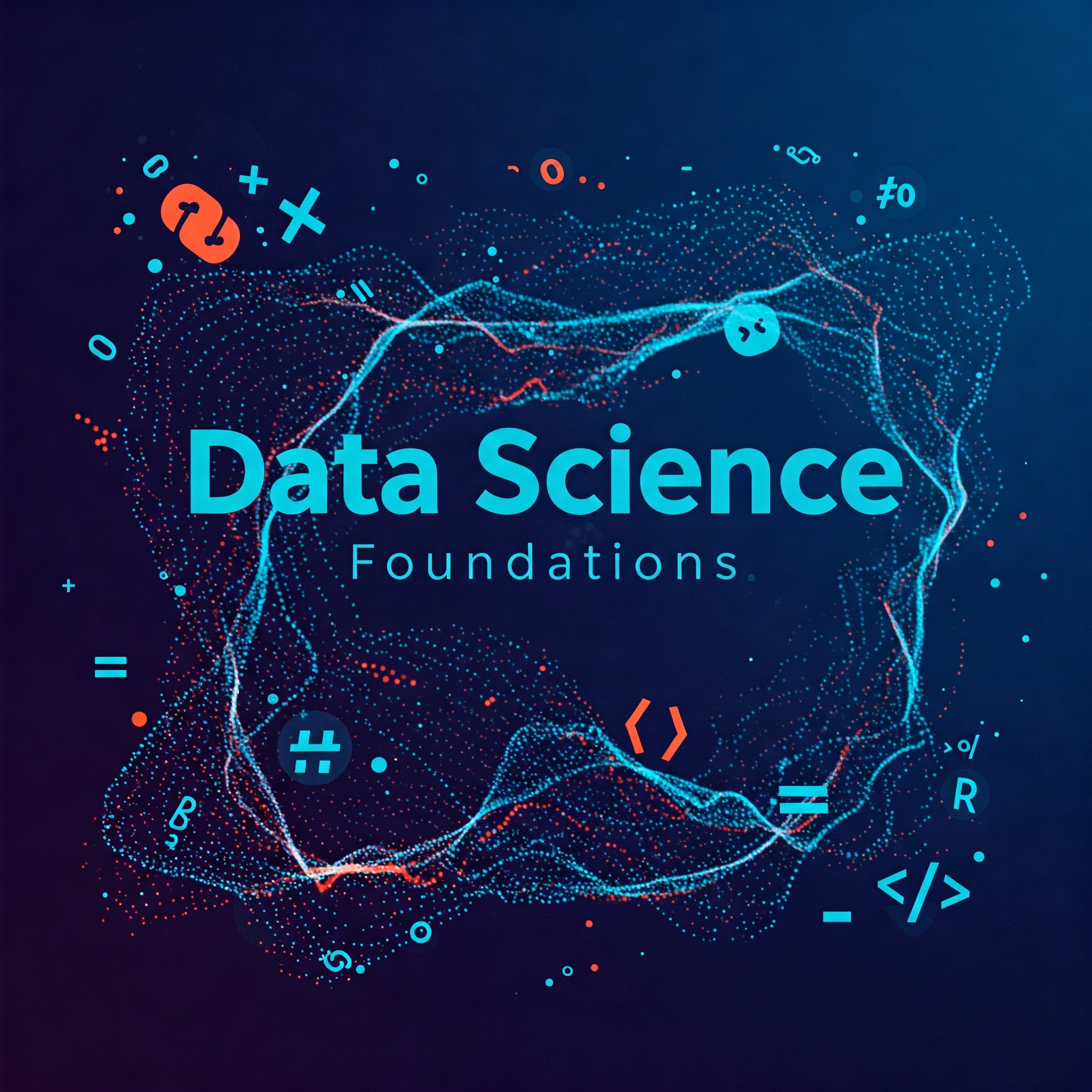Welcome To
The Foundations for Data Science Prerequisite Track1
Track 1 provides essential programming, math, statistics, and data wrangling skills, ensuring learners build a strong foundation before diving into advanced AI applications in Track 2.
Objective: Master Python syntax, loops, functions, and data structures
Build the critical foundation for data science success. Learn Python syntax, problem-solving, and statistical analysis while working with real-world datasets. Perfect for career changers or beginners aiming to tackle advanced data science topics confidently.
🎮 Course Syllabus
🎯 Objective: Build essential programming, math, and data literacy skills before advancing into AI systems. This track is designed for beginners and career changers, providing the foundational knowledge required for data science and machine learning roles.
🔹 Chapter 1 – Python for Data Science
📌 Overview: Introduces Python as the primary programming language for data science. Learners develop coding proficiency and learn to manipulate data efficiently.
✅ Lesson 1.1 – Introduction to Python
- Understanding Python syntax, variables, and data types
- Writing basic Python scripts
✅ Lesson 1.2 – Control Flow & Loops
- If-else conditions, loops (for, while)
- Debugging simple programs
✅ Lesson 1.3 – Functions & Modules
- Writing reusable functions
- Importing libraries for data science
✅ Lesson 1.4 – Working with Lists, Dictionaries & Tuples
- Understanding Python’s data structures
- Optimizing data handling in real-world applications
🛠 Hands-On Project: Build a basic data manipulation pipeline using Pandas
🔹 Chapter 2 – Math & Statistics for Data Science
Bayes’ Theorem
- Probability distributions (normal, binomial)
- Bayes’ theorem for decision-making
✅ Lesson 2.3 – Hypothesis Testing
- Null vs. alternative hypotheses
- P-values, confidence intervals, t-tests
✅ Lesson 2.4 – Linear Algebra & Matrix Operations
- Vector and matrix manipulations
- Applying matrix transformations to datasets
🛠 Hands-On Project: Implement statistical analysis on real-world datasets
🔹 Chapter 3 – Data Wrangling & Preprocessing
📌 Overview: Teaches learners to clean, transform, and prepare data for analysis. Preprocessing ensures accuracy in machine learning models.
✅ Lesson 3.1 – Data Cleaning Techniques
- Handling missing values (imputation, removal)
- Detecting & managing outliers
✅ Lesson 3.2 – Feature Engineering & Transformation
- Scaling, normalization, encoding categorical variables
- Creating new features for better model performance
✅ Lesson 3.3 – Handling Large Datasets Efficiently
- Working with big data frameworks (Dask, PySpark)
- Improving computational efficiency
✅ Lesson 3.4 – Data Formats: CSV, JSON, Excel, Databases
- Importing/exporting structured data
- Querying datasets using SQL
🛠 Hands-On Project: Clean and preprocess financial transaction datasets
🔹 Chapter 4 – Exploratory Data Analysis (EDA)
📌 Overview: Learners master data visualization and statistical insights to better understand patterns and relationships in datasets.
✅ Lesson 4.1 – Data Visualization with Matplotlib & Seaborn
- Creating plots, histograms, scatterplots
- Customizing visualization aesthetics
✅ Lesson 4.2 – Correlation Analysis & Feature Selection
- Identifying relationships between features
- Feature selection for predictive modeling
✅ Lesson 4.3 – Anomaly Detection & Pattern Recognition
- Detecting fraudulent transactions, rare events
- Using clustering and statistical methods
✅ Lesson 4.4 – Automating EDA with Python Libraries
- Pandas Profiling for automated reports
- Using SweetViz for interactive insights
🛠 Hands-On Project: Perform EDA on a customer behavior dataset
🎓 Track 1 Completion Benefits:
✅ Free Certification: IBM Data Science Professional Certificate
✅ Free Internship Opportunity: IBM Data Analyst Internship
✅ Portfolio Formatting Guide: Structuring Jupyter Notebooks & reports
✅ Mock Interview Prep: Python & Data Science Fundamentals
✅ Career Roadmap: Resume workshop, LinkedIn optimization
🎯 Who Is It For?
This course is ideal for:
- Beginners with no prior coding or statistics experience looking to enter the data science field.
- Career changers who need to establish a strong foundation before diving into more advanced topics.
- Self-learners who want a structured approach to programming and data analysis fundamentals.
This course is designed to build essential skills for anyone looking to break into data science. In just four weeks, learners will gain fundamental programming, math, and data literacy knowledge, setting the stage for more advanced studies in machine learning and big data analytics.
Main Benefits:
- Fast-track learning: Master core concepts in just 4 weeks.
- Hands-on practice: Labs and quizzes reinforce real-world applications.
- Industry-aligned skills: Python, statistics, and data wrangling.
- Certification prep: Optional freeCodeCamp & Khan Academy certificates.
Topics of Study:
- Programming Basics with Python: Syntax, loops, functions, and data structures.
- Math & Statistics for Data Science: Mean, variance, distributions, and hypothesis testing.
- Data Literacy & Pre-Wrangling: Spreadsheet skills, data cleaning, and Pandas for data manipulation.


